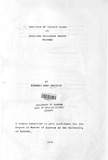| dc.description.abstract | 1. This thesis concentrates mainly on the produce flow to Wakulima Market. This market, since it was opened in 1967, has been beset by the problem of congestion and overcrowding. The former is caused by the fact that vehicles do not use the original parking bays for the intended use. These bays are now sales yard for certain commodities. The latter one is caused by the fact that it is possible in this market to obtain a commodity on retail basis. This acts as a magnet for the low income population of Nairobi who lives close to the market. Overcrowding
also is worsened by the fact that traders scatter the
\
produce allover the ground, thus leaving only a limited area for customers to move along.
The market is untidy, and there are no cold
storage and conditioning facilities.
<
2. A number of persons have nippled the problem
from various dimensions. Wilson in 1969, analysing a two week results came to the conclusion that a total of 38,365 tons was the volume handled in 1969. Heinrich, 1972, obtained 63,741 tons as the volume handled in 1972. Holsten in 1973 estimated the volumes handled in 1973 at 42,482 tons. Lorenzl and Quik, taking into account the quantities lost due to trimmings and spoilage, and the quantity taken outside Nairobi, . • adjusted Heinrich's retail survey figures
and arrived at 82,666, 91,677, 95,066 tons'as quantities handled in 1972, 1973 and 1974 respectively. In all these studies, potatoes, cabbages, maize and bananas predominate amongst the items being traded.
I
The study therefore set to analyse the produce flows within the following objectives.
- To determine the structure of traded commodities.
- To investigate the seasonal fluctuations of the
traded commodities in this market.
I :
xi
3. A number of hypotheses were developed to be tested in the research.
3.1 That the turnover in this market exceeds 95,066 tons estimated for 1974 by 60%.
3.2 That Wakulima Wholesale Market is a market primarily for potatoes, cabbages, green maize and bananas.
3.3 That Tuesdays, and Fridays are relatively the busiest days in the market and that Saturdays and Sundays are the days with the lowest turnover in the market.
3.4 That the sales units are arbitrarily determined in the market.
3.5 That the various sales units of a given commodity do not vary in weight between various seasons.
3.6 That the price reporting system on Fridays of every week has no impact on quantities brought to the market on the following week.
Data to this research was collected from cess receipt books. A total of 40,200 receipts for the whole of 1975 was used. A sales unit survey was also conducted to ascertain the sizes and weights of various sales or carrier units used by traders in this markets.
The following limitations, however, were encountered in the research
— Cess receipt books do not record all the quantities that entered the market. | |

